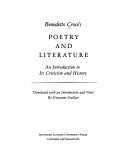| Listing 1 - 10 of 10 |
Sort by
|
Book
Year: 1966 Publisher: Syracuse (N.Y.): Syracuse university press,
Abstract | Keywords | Export | Availability | Bookmark
 Loading...
Loading...Choose an application
- Reference Manager
- EndNote
- RefWorks (Direct export to RefWorks)
Book
Year: 1985 Publisher: Napoli: Societá editrice Napoletana,
Abstract | Keywords | Export | Availability | Bookmark
 Loading...
Loading...Choose an application
- Reference Manager
- EndNote
- RefWorks (Direct export to RefWorks)
Book
ISBN: 9780872911604 0872911608 Year: 1982 Publisher: Lawrence (Ks): Coronado press,
Abstract | Keywords | Export | Availability | Bookmark
 Loading...
Loading...Choose an application
- Reference Manager
- EndNote
- RefWorks (Direct export to RefWorks)
Book
Year: 1966 Publisher: Syracuse
Abstract | Keywords | Export | Availability | Bookmark
 Loading...
Loading...Choose an application
- Reference Manager
- EndNote
- RefWorks (Direct export to RefWorks)
Comparative literature --- Annunzio, d', Gabriele --- France
Book
Year: 1975 Publisher: Banbury Voltaire foundation
Abstract | Keywords | Export | Availability | Bookmark
 Loading...
Loading...Choose an application
- Reference Manager
- EndNote
- RefWorks (Direct export to RefWorks)
Book
Year: 1966 Publisher: Syracuse, N. J Syracuse University Press
Abstract | Keywords | Export | Availability | Bookmark
 Loading...
Loading...Choose an application
- Reference Manager
- EndNote
- RefWorks (Direct export to RefWorks)
Book
Year: 1966 Publisher: Syracuse, NY : Syracuse University Press,
Abstract | Keywords | Export | Availability | Bookmark
 Loading...
Loading...Choose an application
- Reference Manager
- EndNote
- RefWorks (Direct export to RefWorks)
D'annunzio (gabriele) --- Critique et interpretation --- D'annunzio (gabriele) --- Critique et interpretation
Book
ISBN: 0801406641 9780801406645 Year: 1972 Publisher: Ithaca (N.Y.) Cornell university press
Abstract | Keywords | Export | Availability | Bookmark
 Loading...
Loading...Choose an application
- Reference Manager
- EndNote
- RefWorks (Direct export to RefWorks)
Art --- Philosophy --- -Art, Occidental --- Art, Visual --- Art, Western (Western countries) --- Arts, Fine --- Arts, Visual --- Fine arts --- Iconography --- Occidental art --- Visual arts --- Western art (Western countries) --- Arts --- Aesthetics --- -Philosophy --- Beautiful, The --- Beauty --- Art and philosophy --- Analysis, interpretation, appreciation --- Art - Philosophy

ISBN: 0809309823 Year: 1981 Publisher: Carbondale : Southern Illinois University Press ,
Abstract | Keywords | Export | Availability | Bookmark
 Loading...
Loading...Choose an application
- Reference Manager
- EndNote
- RefWorks (Direct export to RefWorks)
Benedetto Croce"s influence pervades Anglo-Saxon culture, but, ironically, before Giovanni Gullace heeded the call of his colleagues and provided this urgently needed translation of 'La Poesia, 'speakers of English had no access to Croce's major work and final rendering of his esthetic theory." " 'Aesthetic, 'published in 1902 and translated in 1909, represents most of what the English-speaking world knows about Croce's theory. It is, asserts Gullace, & no more than a first sketch of a thought that developed, clarified, and corrected itself through new literary experience and more mature reflection.& During the 34 years between 'Aesthetic 'and 'La Poesia '(1936), for example, Croce added a striking new element to his thought: the analysis of prose literature. Gullace's introduction to 'La Poesia 'constitutes a major under­taking in its own right. It is aimed at acquainting the reader with the evolution of Croce's thought and at explaining the relation­ship between this final work and the philosopher's previous work in esthetic theory and literary criticism. " 'La Poesia 'is divided into two parts, text and postscripts. The text consists of four chapters: Poetry and Literature; The Life of Poetry; Criticism and History of Poetry; and The Formation of the Poet and the Precepts. Croce saw the postscripts & as a re­laxed conversation after the tension of theoretical exposition. In Gullace's translation the text and relevant postscripts appear conveniently side by side in a double column. Gullace has anno­tated both text and postscripts.
Literature. --- Poetry.
Book
ISBN: 0813008042 Year: 1985 Publisher: Gainesville University presses of Florida
Abstract | Keywords | Export | Availability | Bookmark
 Loading...
Loading...Choose an application
- Reference Manager
- EndNote
- RefWorks (Direct export to RefWorks)
| Listing 1 - 10 of 10 |
Sort by
|

 Search
Search Feedback
Feedback About UniCat
About UniCat  Help
Help News
News